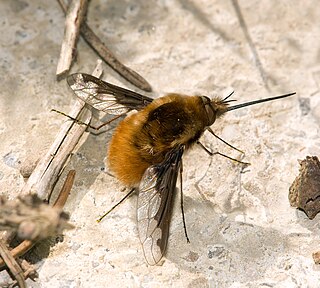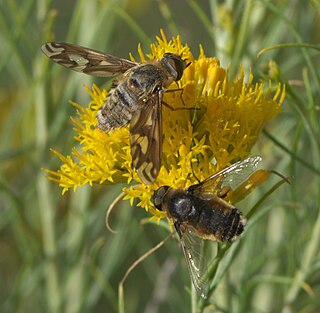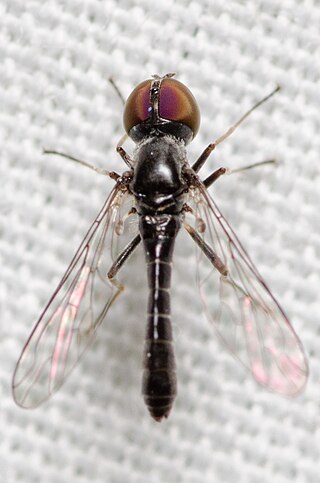
The Bombyliidae are a family of flies, commonly known as bee flies. Some are colloquially known as bomber flies. Adults generally feed on nectar and pollen, some being important pollinators. Larvae are mostly parasitoids of other insects.

Poecilanthrax willistonii, Williston's bee fly or sand dune bee fly, is a member of the Bombyliidae insect family. This family includes the bee flies, true flies that have developed Batesian mimicry characteristics to avoid predators. That is, they look like bees because that helps them avoid bee-wary predators, but they lack stingers.
Exoprosopa parda is a species of bee fly in the family Bombyliidae.

Tomomyzinae is a subfamily of bee flies in the family Bombyliidae. There are six genera and more than 50 described species in Tomomyzinae.
Paracosmus is a North American genus of bee flies in the family Bombyliidae. There are five described species in Paracosmus.
Systropus angulatus is a species of bee fly in the family Bombyliidae. It is found in Texas.
Bombylius comanche is a species of bee flies in the family Bombyliidae.
Bombylius coquilletti is a species of bee flies in the family Bombyliidae.
Exoprosopa dodrina is a species of bee fly in the family Bombyliidae.
Aphoebantus fumosus is a species of bee flies in the family Bombyliidae.
Poecilanthrax ingens is a species of bee fly in the family Bombyliidae.
Xenox xylocopae is a species of bee fly in the family Bombyliidae. It is found in Mexico, Arizona, Texas, and New Mexico.
Lepidanthrax oribates is a species of bee fly in the family Bombyliidae. It is widespread in the western United States from California and Nevada north to British Columbia, Canada.
Paracosmus rubicundus is a species of bee fly in the family Bombyliidae. It is known from Mexico, California, and Arizona.
Rhynchanthrax capreus is a species of bee fly in the family Bombyliidae. It is found in Mexico and the southwestern United States from California to Nebraska.
Paravilla aridula is a species of bee fly in the family Bombyliidae. It is found in Arizona and California.
Hemipenthes inops is a species of bee fly in the family Bombyliidae. It is found in the western United States. It is somewhat unusual compared to other members of the genus Hemipenthes in that its wings are mostly transparent.
Paracosmus insolens is a species of bee fly in the family Bombyliidae. It is known from California and Nevada.
Lepidanthrax arnaudi is a species of bee fly in the family Bombyliidae. It is found in California.
Hemipenthes edwardsii is a species of bee fly in the family Bombyliidae. It is found in the western United States and British Columbia, Canada.


